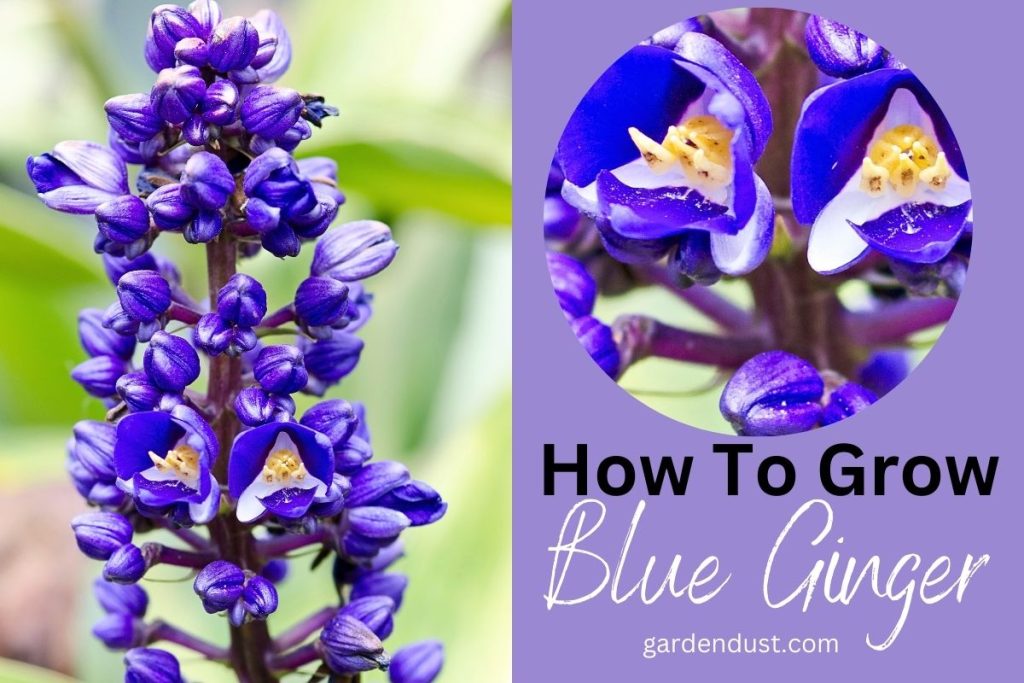Blue Ginger, scientifically known as Dichorisandra thyrsiflora, is a stunning tropical plant that can add a touch of exotic beauty to your garden or indoor space. Native to Brazil, Blue Ginger is renowned for its vibrant blue flowers and lush, glossy foliage. Growing this plant successfully requires a combination of proper care, the right environment, and attention to detail. In this comprehensive guide, we will explore step-by-step instructions on How To Grow Blue Ginger, ensuring that you can enjoy its captivating beauty to the fullest. Let’s start….
Botanical Name- Dichorisandra thyrsiflora
Genus-Dichorisandra
Family- Commelinaceae
Common Name-Blue Ginger
Native-Brazil
Flower Colour-Blue
Blooming Time- late spring to early summer
Care For Blue Ginger
Sunlight
Blue Ginger, scientifically known as Dichorisandra thyrsiflora, is a shade-loving plant that thrives in specific sunlight conditions. Optimal growth is achieved in partial to full shade, making it well-suited for areas with filtered sunlight or dappled shade. While it can tolerate some morning sun, protection from intense afternoon sunlight is essential to prevent leaf scorch. Providing the right balance of shade ensures that Blue Ginger can display its vibrant blue flowers and lush foliage to their fullest potential.
Water
Proper watering is crucial to the well-being of Blue Ginger. This tropical plant prefers a consistently moist environment without allowing the soil to become waterlogged. Aim to keep the soil consistently moist, watering when the top inch feels dry to the touch. However, it’s essential to strike a balance and avoid overwatering, as Blue Ginger is susceptible to root rot in consistently waterlogged conditions. Using filtered or rainwater, and applying a layer of organic mulch, helps maintain the ideal moisture levels and supports the overall health of the plant.
READ ALSO:-How to Grow and Care for Watercress
Fertilizer
Fertilizing Blue Ginger is a key component of its care regimen, contributing to healthy growth and vibrant blooms. Choose a balanced, water-soluble fertilizer with equal parts nitrogen (N), phosphorus (P), and potassium (K), such as a 10-10-10 or 14-14-14 formulation. Apply the fertilizer every 4-6 weeks during the growing season, typically spanning from spring through summer. It’s crucial to follow the recommended dosage on the fertilizer package to avoid over-fertilizing, which can lead to salt buildup in the soil and negatively impact the plant’s health.
Soil Requirements
Creating the right soil environment is essential for Blue Ginger to thrive. Start by ensuring well-draining soil enriched with organic matter like well-rotted compost or aged manure. Blue Ginger prefers slightly acidic to neutral soil with a pH range of 6.0 to 7.0. Testing the soil and adjusting the pH if needed using lime or sulfur helps create an optimal growing medium. Adequate drainage is critical, and incorporating materials like perlite or sand into the soil promotes the prevention of root rot, a condition that Blue Ginger is susceptible to if the soil remains consistently waterlogged. By addressing these soil considerations, you provide a solid foundation for the successful cultivation of Blue Ginger in your garden or indoor space.
Is Blue Ginger Is Real Ginger ?
No, Blue Ginger (Dichorisandra thyrsiflora) is not the same as culinary ginger (Zingiber officinale). Blue Ginger belongs to the Commelinaceae family, while culinary ginger is a member of the Zingiberaceae family. Unlike culinary ginger, Blue Ginger does not produce edible rhizomes; its appeal lies in its vibrant blue flowers and lush foliage, making it a popular ornamental plant in tropical and subtropical regions.
Propagated Through Division
Blue Ginger (Dichorisandra thyrsiflora) can be propagated through division in spring. Hydrate the plant before gently lifting it to expose the rhizomes. Use a clean knife to separate rhizomes with roots and shoots. Optionally, dip cut ends in rooting hormone. Plant divisions in well-prepared soil, ensuring the top of each rhizome is just below the surface. Water thoroughly and maintain soil moisture during establishment. This straightforward method allows for the easy expansion of Blue Ginger, ensuring a continued display of its vibrant blue flowers and lush foliage.
Common Problems
Blue Ginger (Dichorisandra thyrsiflora) may encounter occasional challenges despite its hardiness. Pests like aphids and spider mites can be addressed with water or insecticidal solutions. To prevent root rot, maintain well-draining soil and moderate watering. Yellowing leaves may signal overwatering or nutrient deficiencies, requiring adjusted watering and occasional fertilization. Fungal diseases can be avoided with proper spacing and watering practices. Protect Blue Ginger from leaf burn by placing it in partial to full shade, and ensure it is shielded from cold temperatures below 50°F. Regular monitoring and prompt action will help keep Blue Ginger healthy and visually appealing.
Growing Blue Ginger can be a rewarding experience, allowing you to enjoy the exotic beauty of its blue flowers and lush foliage. By providing the right environment, proper care, and attention to detail, you can cultivate healthy, thriving plants that will bring a touch of the tropics to your garden or home. Follow the guidelines outlined in this comprehensive guide, and soon you’ll be rewarded with the vibrant and stunning presence of Dichorisandra thyrsiflora in your surroundings. Happy Gardening….






